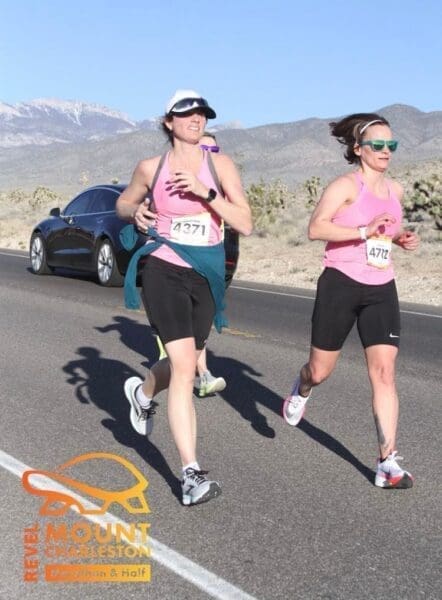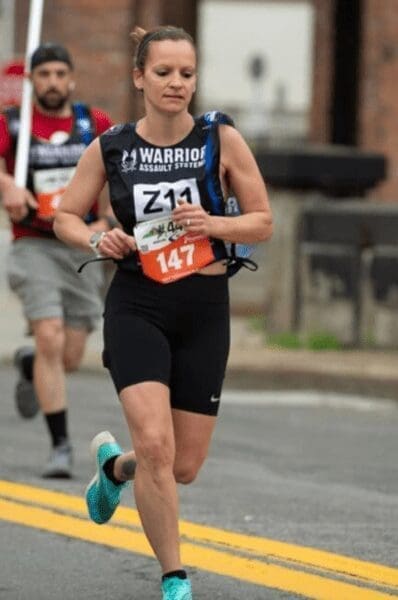Six days a week, local friends Kristina Tomlan and Nikkol Zanes strap on their runner shoes and hit the roadways of the Ohio Valley.
Both have careers, and both have full lives that keep them busy, yet the two hold each other accountable as they log 60-plus miles of road work each week.
But why? To stay in shape? For fitness purposes? For the sheer fun of it? Yes, all of those play a part.
Right now? All that work has led up to April 17, a week from Monday. Then, the two will travel to Massachusetts to compete in the 127th running of the famed Boston Marathon.
For Tomlan, it’s her fifth running of the Boston. For Zanes? It’ll be her first. Both women lead busy lives, but adjust those lives and their crowded schedules to find time to train. This is the Boston Marathon, and work must be done.
“Having a friend to hold you accountable every morning is much easier than getting up early to run alone,” Tomlan admitted. “We are in this together and work around our busy schedules to make our training plan work.
“I’m super excited to watch Nikkol experience it for the first time. She has worked so hard to get where she is and deserves this so much.”
“I know that we will push each other to finish no matter what,” Zanes added. “When you’re alone you have no one to help you except yourself and your thoughts and it’s awesome to have Kristina there with me.”
Both know a thing or two about running.
Zanes has been running successfully for years, including finishing as the top local finisher at last year’s Ogden Newspapers Half Marathon in downtown Wheeling, coming in 11th overall.
She’s run short distances, half marathons, marathons, and even an ultra-marathon previously. Even with her experience, that race, she admits, took its toll.
“One time I ran an ultra marathon, which was 50 miles,” Zanes said. “It was very grueling because it took me 14 hours—yes, 14 hours—of running.”
Tomlan too has partaken in distance running throughout the years, but she came to distance running from a track background, having qualified multiple times for the Ohio state high school track meet, in both the 300 intermediate hurdles and relay events.
Her transformation to long distances really started when she worked her way through physical therapy school.
“Two of my teachers in PT school ran many full marathons and they talked me and my friends into doing one back in 2008,” Tomlan recalled. “I ran three a year for a while, then took a four-year hiatus from racing.”

Qualifying
For many racers, runners wishing to compete need only sign up, pay their entry fee, then prepare for race day.

The Boston Marathon is different. First, you must qualify.
There are age brackets and gender brackets, each with a minimum qualifying time a participant must meet at an accepted marathon elsewhere in the country. For example, if a 25-year-old young woman wanted to race, she would have to finish a qualifying marathon in 3 hours, 30 minutes, or less.
But reaching a qualifying time doesn’t me a runner gets accepted. There are annually thousands of runners who run a qualifying time who are NOT accepted to run in the Boston.
In 2021, the field was limited to 20,000 participants instead of the usual 30,000. That year, 9,215 runners who qualified to compete were denied entry.
So, while running a qualifying time gives you a shot to compete, it’s best to do a little better to ensure a spot.
“They only take so many participants per age group, so it is recommended that if you want to qualify, you run a little faster than that qualifying time to give yourself a cushion,” Tomlan said. “I ran a 3:26, which gave me around nine minutes of cushion.”
Zanes has run in big races before, including the Marine Corps Marathon in Washington D.C. with a field of 30,000-plus.
She’d tried multiple times to qualify for Boston, but along with her friend, the pair finally managed to post a qualifying time during the Mount Charleston Marathon in Las Vegas back in April of 2022.
It took a lot of hard work from Zane to constantly improve her time, but she bested the 3 hours, 40 minutes barrier she needed to qualify.
“It took me about seven marathons to even come close to qualifying for Boston,” Zanes admitted.
Remember Tomlan mentioned her four-year hiatus? Returning to running is one thing. A seasoned athlete doesn’t require much coaxing to strap the running shoes back on. But to qualify for the Boston?
“After taking four years off from racing, claiming I was “retired from racing” Nikkol twisted my arm and talked me into training for a full marathon again,” Tomlan said. “I was super proud to qualify for Boston because I didn’t believe I had it in me anymore to run that fast.”
That’s a Lot of Miles
A marathon is 26.2 miles in length. For perspective, that’s roughly the equivalent of setting off from the parking lot at Wesbanco Arena in Wheeling and running across the Fort Henry Bridge, into Ohio, and finishing at the entrance to the Dickinson Cattle Company. In Barnesville.

In short? It’s far.
So how does one manage to push their body past its physical limits to complete such a task, in fewer than four hours no less.
“The key is to put the training in and do your best,” Tomlan admitted. “When people ask me for advice, I tell them you can train all you want and can still have a bad race. Weather, sickness, start times, travel, elevation, and injuries—all can make you have a bad race.
“However, 26.2 miles is a long distance and it’s mentally taxing.”
Zanes agrees. There’s a “wall” every runner hits in a race, the point where he or she feels like they physically can run no more. From there, it’s all a mental battle.
“It’s what we runners call the wall, and it usually happens after mile 20 when you physically have nothing left to give, but mentally, you have to keep pushing through,” Zanes said. “You tell yourself that you have trained for this and that you can do this, even when you get tired.
“You keep going, knowing that you will see that finish line.”


